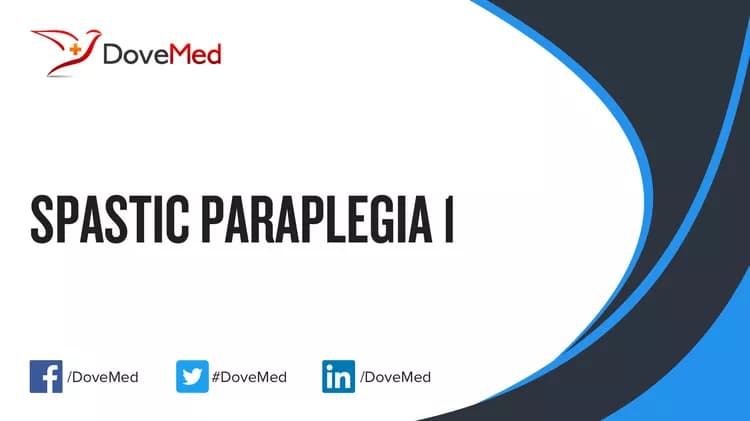What are the other Names for this Condition? (Also known as/Synonyms)
- Adducted Thumb with Mental Retardation
- Gareis-Mason Syndrome
- Mental Retardation Aphasia Shuffling Gait Adducted Thumbs Syndrome
What is Spastic Paraplegia 1? (Definition/Background Information)
- Spastic Paraplegia 1, also known as Mental Retardation Aphasia Shuffling Gait Adducted Thumbs syndrome or MASA Syndrome, is a historical term used to describe a phenotype now considered to be part of the X-linked L1 clinical spectrum
- MASA Syndrome is characterized by mild to moderate intellectual deficit, delayed development of speech, hypotonia progressing to spasticity or spastic paraplegia, adducted thumbs, and mild to moderate distension of the cerebral ventricles
(Source: MASA syndrome; Orphanet, National Institute of Health and Medical Research (INSERM), Paris.)
Who gets Spastic Paraplegia 1? (Age and Sex Distribution)
- Spastic Paraplegia 1 is a rare congenital disorder. The presentation of symptoms may occur at birth
- The disorder predominantly affects males
- Worldwide, individuals of all racial and ethnic groups may be affected
What are the Risk Factors for Spastic Paraplegia 1? (Predisposing Factors)
- A positive family history may be an important risk factor, since Spastic Paraplegia 1 is an inherited condition
- Currently, no other risk factors have been clearly identified for the condition
It is important to note that having a risk factor does not mean that one will get the condition. A risk factor increases one’s chances of getting a condition compared to an individual without the risk factors. Some risk factors are more important than others.
Also, not having a risk factor does not mean that an individual will not get the condition. It is always important to discuss the effect of risk factors with your healthcare provider.
What are the Causes of Spastic Paraplegia 1? (Etiology)
- Mutation(s) in L1CAM gene are reported to cause Spastic Paraplegia 1
- The condition is inherited in an X-linked recessive manner
X-linked recessive pattern of inheritance: The gene associated with this condition is located on the X chromosome, which is one of the two sex chromosomes. In males (who have only one X chromosome), one altered copy of the gene in each cell is sufficient to cause the condition. In females (who have two X chromosomes), a mutation would have to occur in both copies of the gene to cause the disorder. Because it is unlikely that females will have two altered copies of this gene, males are affected by X-linked recessive disorders much more frequently than females. A characteristic of X-linked inheritance is that fathers cannot pass X-linked traits to their sons.
What are the Signs and Symptoms of Spastic Paraplegia 1?
The signs and symptoms of Spastic Paraplegia 1 may vary in type and severity among affected members, even within a family, and include:
- Adducted thumb
- Hydrocephalus
- Hyperlordosis
- Kyphosis
- Macrocephaly
- Microcephaly
- Pes cavus
- Shuffling gait
- Strabismus
- Talipes equinovarus
Based on the frequency of symptoms observed, the following information may be noted:
Very frequently present symptoms in 80-99% of the cases:
- Aphasia
- Delayed speech and language development
- Gait disturbance
- Hand clenching
- Hemiplegia/hemiparesis
- Hyperreflexia
- Intellectual disability
- Short stature
- Spastic paraplegia
Frequently present symptoms in 30-79% of the cases:
- Camptodactyly of finger
- Clinodactyly of the 5th finger
Occasionally present symptoms in 5-29% of the cases:
- Agenesis of corpus callosum
- Ventriculomegaly
(Source: Spastic Paraplegia 1; Orphanet, National Institute of Health and Medical Research (INSERM), Paris.)
How is Spastic Paraplegia 1 Diagnosed?
Spastic Paraplegia 1 is diagnosed on the basis of the following information:
- Complete physical examination
- Thorough medical history evaluation
- Assessment of signs and symptoms
- Laboratory tests
- Imaging studies
- Biopsy studies, if necessary
- Molecular genetic testing to check for or confirm causative L1CAM gene mutation(s)
Many clinical conditions may have similar signs and symptoms. Your healthcare provider may perform additional tests to rule out other clinical conditions to arrive at a definitive diagnosis.
What are the possible Complications of Spastic Paraplegia 1?
The complications of Spastic Paraplegia 1 may include:
- Difficulty in grasping and lifting objects
- Learning disability
Complications may occur with or without treatment, and in some cases, due to treatment also.
How is Spastic Paraplegia 1 Treated?
There is no cure for Spastic Paraplegia 1, since it is a genetic condition. The treatment is usually given to manage the signs and symptoms and any complication that develops.
How can Spastic Paraplegia 1 be Prevented?
Currently, Spastic Paraplegia 1 may not be preventable, since it is a genetic disorder.
- Genetic testing of the expecting parents (and related family members) and prenatal diagnosis (molecular testing of the fetus during pregnancy) may help in understanding the risks better during pregnancy
- If there is a family history of the condition, then genetic counseling will help assess risks, before planning for a child
- Active research is currently being performed to explore the possibilities for treatment and prevention of inherited and acquired genetic disorders
Regular medical screening at periodic intervals with tests and physical examinations are recommended.
What is the Prognosis of Spastic Paraplegia 1? (Outcomes/Resolutions)
- The prognosis of Spastic Paraplegia 1 is dependent upon the severity of the signs and symptoms and associated complications, if any
- Individuals with mild conditions have better prognosis than those with severe symptoms and complications
- Typically, the prognosis may be assessed on a case-by-case basis
Additional and Relevant Useful Information for Spastic Paraplegia 1:
Spastic Paraplegia 1 may also be known by the following additional synonyms:
- Clasped Thumb and Mental Retardation
- Crash Syndrome
- MASA Syndrome
- Thumb Congenital Clasped with Mental Retardation
The following DoveMed website link is a useful resource for additional information:
Related Articles
Test Your Knowledge
Asked by users
Related Centers
Related Specialties
Related Physicians
Related Procedures
Related Resources
Join DoveHubs
and connect with fellow professionals


0 Comments
Please log in to post a comment.